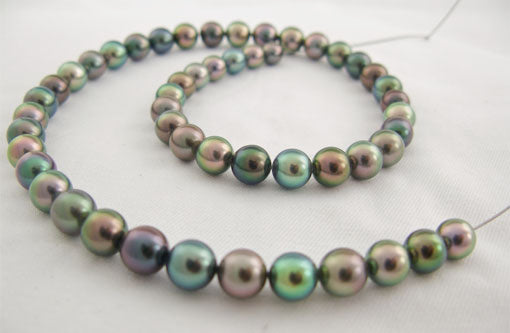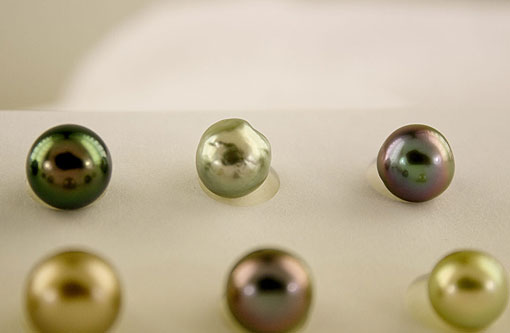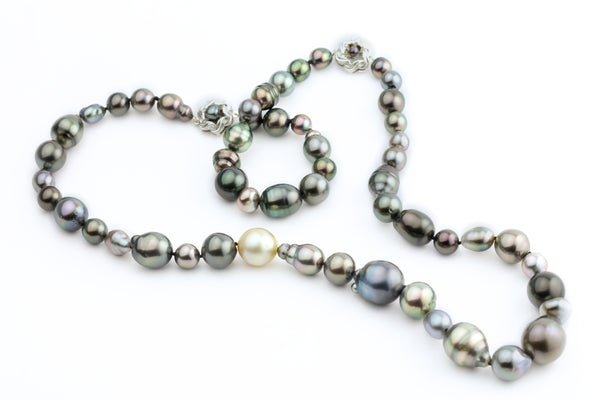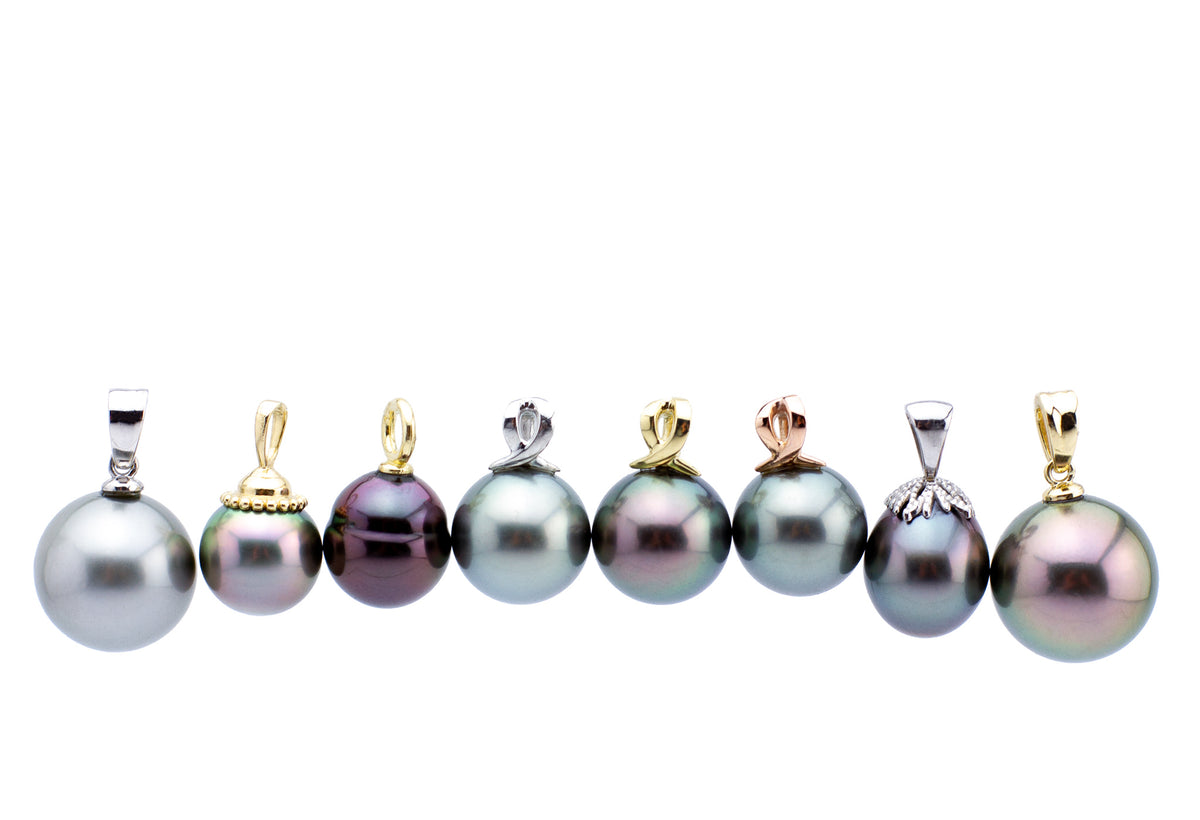Choosing A Pearl

Choosing a pearl can be a daunting task, especially when given the variety of shapes and colors available with Tahitian pearls.
Here is a short guide to deciphering the pearl world. Pearl classification is notoriously arbitrary so for simplicity's sake we'll keep to the official system put into place by the Tahitian government.
The value of pearls is governed by the following factors in order of importance: size, quality and shape. However we believe the most important factor when choosing a pearl is that you love it. Remember that each pearl is one-of-a-kind. Certain pearls, regardless of their objective value, will just make your heart sing.

Size
Cultured, Tahitian black pearls typically range in size from 7 to 18mm in diameter. Larger pearls exist but anything beyond 16mm is extremely rare.
Quality classifications
Under the Tahitian system, quality is broken down into A, B, C and D categories. Another system of grading exists that is defined by A through AAA, and this is used more frequently by those who sell many types of pearls (such as Akoyas, Chinese freshwater pearls, etc), not just Tahitian pearls. Both systems are valid but are always based on the subjectivity of the seller.
Pearl quality under the Tahitian system is assessed in the following way:
*A grade pearls are officially 90% perfect with great luster and no more than two imperfections within 10% of an allotted surface.
*B grade pearls must have great luster as well but only 70% of the total surface has to be without flaws.
*C grade pearls must have decent luster with 40% of the surface being clean of imperfections. These pearls often find themselves in strands as drilling from one side to the other tends to conceal what can't be hidden in pendant or ring settings.
*D grade pearls are more characterized by their consummate flaws than anything else. Luster is variable.
At Kamoka we prefer not to define our pearls by grade but rather to use high resolution, un-tampered with imagery and our product descriptions to show and describe what our pearls look like. We feel that this is a more honest approach and by doing this we can avoid our own subjectivity.

Nacre thickness
Nacre thickness is the layer of pearly shell that covers a nucleus. If a pearl is harvested too early it will have a thin layer of nacre than could potentially wear away leaving you with a dull pearl.
The Tahitian government used to imposes a minimum .8mm nacre thickness on all pearls exported. Nowadays there are no export standards so the only way to make sure your pearl has a thick layer of nacre is to have it x-rayed. It's best to buy pearls from sources of integrity to be sure you're getting a pearl with sufficient nacre thickness since most people will not be able to x-ray their pearls. At Kamoka we never harvest our pearls before they have achieved at least .8mm of nacre and often our pearls have much more than that.

Color & Luster
Luster heavily influences quality. If you have a 18mm round, green pearl that doesn't shine, you don't have anything to get excited about. The finest pearls will have a liquid-like aspect to them with the layers glowing from within, like out of a bowl of water.
Color is a very subjective official criterion for judging quality. To us it's everything, because as farmers we are always striving for the most perfect, colorful pearls we can produce. Regionally however, preference varies wildly. Europe likes lighter shades as well as silver tones while Asia leans heavily on the darks. The US and Canada seem to be somewhere in the middle, with a lean towards a more lively color palate.

Orient
Orient is interpreted differently in other kinds of pearls but as it relates to Tahitian black pearls, it is seen as the centrally arranged color progression. Again, imagine the luster as a bowl of water – now make the water have transparent layers in different colors that don’t mix but rather set off the bright tones even more. The amazing range of colors found in Tahitian pearls can often be represented in a single pearl, as observed from the center outward. Colors are often mixed in unlikely combinations. Only on a Tahitian pearl can you have contrary colors like pink and green that don't blend, but halo each other beautifully.

Shape
Tahitian black pearls vary wildly in shape from perfect rounds to the amorphous and elongated. Note that in the following definitions, an axis of symmetry means that you can drill it from one end through to the other, spin the pearl along that axis and not see it wobble.
Shapes can be described in the following categories:
*Round pearls are the most classic and a good starting point. To be classed as round they must have a diameter variance of less than two percent. This means that a 10mm pearl cannot be larger than 10.2 or 9.8mm if measured across a different diameter.
*Semi-round pearls are usually mixed with rounds because of they look almost the same. They are allowed a diameter variance of two to five-percent, which is when the difference becomes noticeable to the eye. Most pearls have an axis of symmetry.
*Baroques have no axis of symmetry, meaning that they can be anything from a round pearl with a bump on the side to wild, wavy or bulbous shapes. They have a lot of personality and are our personal favorites.
*Semi-baroque is a large category that covers everything with only one axis of symmetry. This means that drops, buttons (a sort of squashed round that’s flatter on one side), ovals and all of their variations.
Most agree that a perfect drop is every bit as valuable as a perfect round, no doubt due to its rarity.
*Circled pearls have concentric rings etched into the form of the pearl. Some circled pearls may only have a small percentage of surface covered in these rings while others may be etched all over. It's unknown why but circled pearls are by far the most colorful.
Tahitian Keshi Pearls
Keshi are a happy accident of pearl culture. If the oyster manages to push out the shell nucleus after the pearl culturing operation, the small piece of mantel tissue that was also placed inside the oyster, can still create a small pearl. The result is a 100% solid, non-nucleated pearl called a keshi. Keshi are often small and extremely baroque although they can also grow quite big and can be smooth and round.
